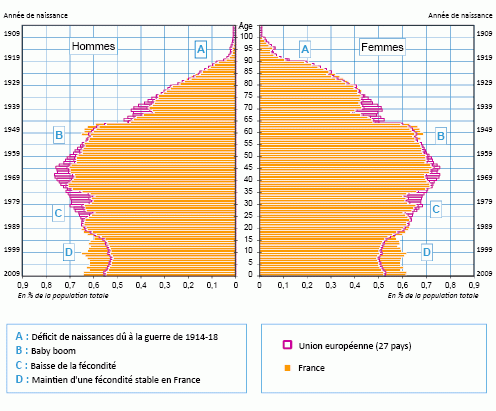2010 population pyramids of France and the European Union

Reading the graph
Ages are figured on the vertical axis. Men are represented on the left, women on the right. Horizontal bar length indicates the proportion of the population made up of men and women of that age. For example, in 2010, boys under one year accounted for 0.64% of the total population of France.
The French and European Union population pyramids have been superimposed; the overall "profile" of the 27 European member states at the same date is represented in pink (either a pink surface or line). This allows for comparing the two population structures in terms of sex and age.
Fertility is higher in France than in the EU as a whole
France’s population pyramid for 2010 was shaped by twentieth-century history: a birth deficit during the 1914-1918 war years, the baby boom of 1946-1973, relative birth rate stability for the past 35 years. The male and female populations are nearly equal in size, except at very old ages-ages reached by more women than men. The numbers are higher in France than in the EU as a whole (in pink) for all ages up to 22 years. Children below one year represent 1.3% of the French population (0.64 + 0.61) as opposed to only 1.1% (0.55 + 0.51) for the EU at large. This is because the post-baby boom fall in the birth rate was not as sharp in France as in the EU as a whole, where the number of births fell continuously for approximately 35 years (from 1964-2000).
The EU’s projected population increase is lower than France’s
Number of births has been rising slightly in the EU since 2002; fertility is on the upturn. Yet it remains far below France’s 2 children per woman; in 2009 it was estimated at 1.59. And even if the rise continues, if will not prevent a new fall in births because the number of women of childbearing age is falling. So as mortality and immigration continue to fall, the EU’s population will increase but only slowly, and it will not exceed 525 million inhabitants (today it has 501 million). In France, by contrast, fertility has stabilized around 2 children per woman and the number of births has remained virtually constant for the last 35 years, suggesting greater population growth than in the EU, though the pace of increase should gradually slow. INSEE forecasts that France’s population will cross the threshold of 70 million inhabitants around 2037 (it stands at 63 million today). At the same time, the population and its "structure" will be ageing as the large generations born during the baby boom (see Figure) gradually move into old and extremely old age: in 2036, one-fourth of the population will be over 65, as opposed to slightly under 17% today.
Sources
Population figures are published by Eurostat, the EU’s statistics office, which calculates them on the basis of information provided by member states. National statistics offices count their populations using civil registry information and general censuses, while taking into account population developments-births, deaths, immigration-that have occurred between censuses.
Online: June 2012
